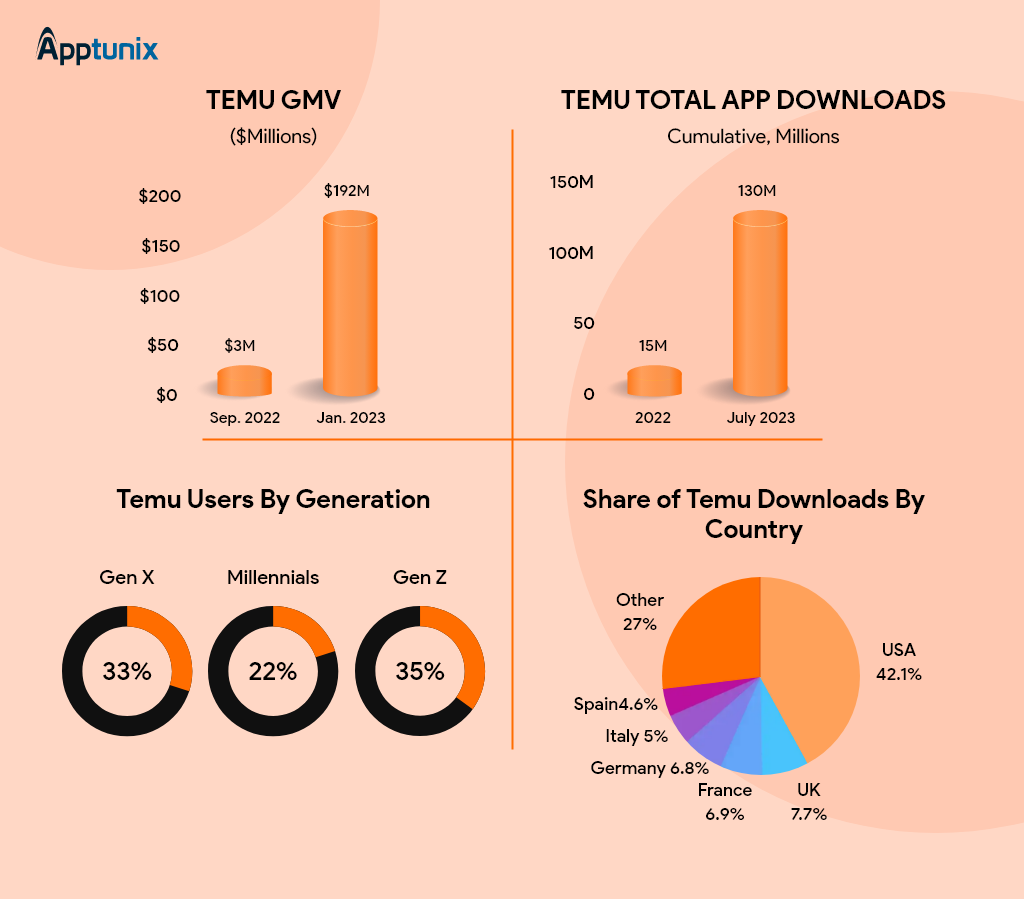Planning to launch your shopping app in the global eCommerce market? – You’re in the right place!
If we look at the stats – Over 80% of people purchase products through their smartphone devices. In 2022 alone, the US had 268 million online shoppers; by 2025, this number is expected to reach 285 million.
To ensure success for your shopping app, setting the right inspiration to kickstart your business is crucial. That’s where Temu comes in – an online marketplace that has rapidly established itself among the top eCommerce players.
In today’s guide, we will cover the process of developing a shopping app like Temu, associated costs, and other factors. But before diving in, let’s look at Temu’s market overview.

Temu Business & Revenue Model
Temu gets its products straight from the manufacturers through Pinduoduo’s supply chain. This helps keep costs low and offers a wide variety of items. They offer competitive prices, flash sales, and discounts, which attract many users and boost sales.
Temu’s group buying method is also popular. As more people join in to buy a product, the price drops, leading to more sales, even though the profit margin on each item is low.
Temu Revenue Model: How Does Temu Make Money?
Temu generates revenue from transaction fees, commissions on sales, and advertising. It can make money off of these while keeping pricing low.
For every transaction made using the app, they charge sellers fees and keep a small portion of the sale price. Advertising is also crucial to them as advertisers pay them to promote their products.
3 Reasons You Should Invest in Shopping App
Before starting any business endeavor, it is crucial to comprehend why a particular industry is the right market to invest in.
Here, we’ve listed three compelling reasons why developing a popular software like Temu is desirable.

1. Rising Trend in Mobile Commerce
The mobile shopping market is set to explode from $420.2 billion in 2023 to $1,709.6 billion by 2028, growing at 32.4% annually.
Customers are increasingly turning to mobile shopping apps due to the convenience of smartphones. With mobile commerce, these apps can seize the opportunity to provide shoppers with a seamless eCommerce experience. Investing in shopping apps like Temu, which cater to online shoppers, could be highly profitable.
2. Huge Market Potential
Statistics show that in 2023, 20.8% of retail purchases will likely be conducted online, and e-commerce sales are rising rapidly.
E-commerce can assist you in reaching your objectives, whether to expand your startup into a large business or boost sales. Moreover, the majority of your customers are online. Investing in a shopping app similar to Temu is essential to connect with your target audience through the right platform.
3. Revenue Opportunities
The global e-commerce market is expected to total $6.3 trillion in 2023 and the market is expected to total over $8.1 trillion by 2026.
Every entrepreneur wants to invest in a business that offers enormous revenue opportunities. Undoubtedly, the data states that the eCommerce market stands among the most profitable companies now and in the coming years.
So, if you’re planning to invest in shopping apps similar to Temu – it’s the right time to get started, or you’ll miss out on generating huge profits.

Must-Have Features to Include in eCommerce App-Like Temu
Incorporating essential features in your shopping mobile app like Temu is crucial if you want to make it a success. Here’s a list of core features that you should consider:

1. Registration and Login
The first thing that users require to join any app is the registration and login feature. They must create an account, set up their profiles, input their details, choose payment gateways, etc. You must have a seamless onboarding process to make a good impression on your users.
2. Product Listing
Listing products with detailed descriptions and high-quality images is crucial in eCommerce apps. A cluttered product listing will frustrate your customers. It will hinder the overall user experience and force them to leave the app.
So, you must focus on the following critical features for product listing. It includes:
- Product thumbnails
- Comprehensive product description
- Filter and sorting options
- Responsive and appealing design
- Infinite scroll or Pagination
- Direct Call-to-Action (CTA) button
- Clear navigation
All these factors help to enhance customer experience and facilitate decision-making.
3. Shopping Cart
This feature offers convenience for users to choose and manage products they wish to purchase. It helps users save time and effort repeatedly browsing and searching for the product. Customers can easily add or remove products from the cart. Also, they can complete the purchase.
Putting things in one location encourages people to buy more, which boosts revenue. Everything in one place also makes the checkout process easier and more efficient for users.
4. Payment Gateway Integration
Integrating a payment gateway in a shopping app must be seamless and secure. This feature enables users to make payments within the shopping app, ensuring customer satisfaction.
If we talk about the Temu app, the payment gateway includes – PayPal, Braintree, and Stripe. Each of them has different features and fees.
5. Order Management
This feature covers users placing orders and their delivery at their doorsteps. It includes the following stages –
- Customer order
- Inventory management
- Order fulfillment
- Packaging
- Shipping
- Tracking
- Follow-up
This feature is beneficial to both parties. Businesses can manage inventories and carry out orders with on-time delivery. On the other hand, it allows customers to track their orders and get fast delivery.
Ultimately, integrating this feature helps to fulfill orders, boost customer satisfaction, and build a brand reputation.
6. Personalized Recommendation
Gathering user data, preferences, and behavior helps businesses to target them with personalized recommendations. It helps to enhance customer engagement and boost sales. Moreover, companies can drive more conversions, generate profits, and build stronger customer relationships.
7. Push Notifications
“Your order is out for delivery” – Such push notifications allow customers to keep track of their orders. Integrating notification features lets customers get all the updates on their orders or new sales.
Push notifications help to boost customer engagement, increase traffic, drive conversions, and enhance brand loyalty.
8. Analytics and Reporting
Analytics and reporting features allow sellers to make informed decisions on stocking, inventory, restocking, etc. It helps businesses grow by following the right strategy and trends.
Moreover, this feature gives businesses insights into target markets, implements marketing campaigns, and minimizes operational risks.
9. Customer Service
Every business wants to keep its customers happy. – But many businesses fail because of that. You must integrate unique customer service features to satisfy your customers. It includes live chat, support tickets, email support, FAQs section, and social media channels.
Create a Shopping App-Like Temu: Step-by-Step Guide
Following, we’ve listed a step-by-step guide to developing a shopping app like Temu. Let’s learn:

Step 1: Planning & Market Research
The very first step is to have solid planning and comprehensive market research. It would help if you clearly defined the purpose and goal of your project. In addition, conduct thorough market research to understand your target market and competition.
List all the segments of your app that will assist you in targeting the right audience. Identifying key features and functionalities is crucial depending on market demand and user needs.
Step 2: Key Components
Before developing your online shopping app, consider these essential components:
- Domain name: This is the web address customers will use to reach your store. Choose a brief, unique name relevant to your brand or products.
- Shopping cart: This software enables customers to add items, manage their selections, and proceed to checkout—research various options to find the best fit for your app.
- Payment processor: Choose a payment gateway to accept transactions. Research different providers to select one that suits your needs; PayPal is commonly used for small businesses.
Step 3: UI/UX Design
Having a unique and appealing design for your shopping app is highly important. It must be convenient for users to navigate easily through the app.
When designing an online shopping app, keep the following points in mind:
- Pick a theme that complements the visual identity of your brand or company.
- Make sure that users can navigate with ease and clarity.
- Use high-quality photos to improve the way your products are presented.
- Include client reviews or evaluations to establish credibility and trust.
- Make the most of white space to create a modern, streamlined look.
An intuitive, attractive, and accessible UI UX design will improve and enhance user experience and engagement.
Step 4: Choosing the Right Tech Stack
The most crucial step in the development process of eCommerce software is choosing the right tech stack. Select the right technologies and frameworks for developing your app based on scalability, performance, and compatibility requirements.
Consider factors like frontend development (e.g., React Native, Flutter), backend development (e.g., Node.js, Django), and database management (e.g., MongoDB, PostgreSQL).
Step 5: Development Process
Here, developers integrate all the features and functionality with other components while working on the front-end and back-end code.
The shopping app’s development depends upon various elements, including complexity, functionality, and design. Also, the development phase can take longer depending on the project’s complexity.
Note:
You can opt for MVP (Minimum Viable Product) to develop your shopping app with basic features. You can go with this option if you want to create a shopping app on a low-cost budget.
Once you have tested your app in the market and get a clear idea about trends, audience, and market – you can go for a fully-developed app with advanced features. You can obtain funding from investors and stand firm in the market.
Step 6: Testing & Quality Assurance
Once your shopping app is developed – the next step is testing and quality assurance. Conduct comprehensive testing to identify and address any bugs, errors, or usability issues.
Perform functional, usability, compatibility, and security testing to ensure the app meets quality standards. Next, iterate on feedback and make necessary improvements before proceeding to deployment.
Step 7: Deployment
Once everything is developed, it’s time to launch your shopping app like Temu on the Play Store or Apple Store. Make sure to ensure compliance with legal regulations.
How Much Does it Cost to Develop an App-Like Temu?
Depending on several factors, the estimated cost to develop an app like Temu ranges between $25,000 to $50,000. These factors include features & functionality, design, tech stack, etc.
Also, the cost may significantly increase with advanced features ranging up to $80,000 or above.
Partner With Apptunix to Kickstart Your Shopping App Like Temu
Developing a shopping app like Temu requires strategic planning and the right mobile app development company like Apptunix.
We specialize in crafting shopping apps with cutting-edge features and functionalities. Our skilled team will guide you through seamlessly integrating innovative technology into your app. With our tailored shopping app solutions, you can elevate your business to new heights.
Don’t wait any longer—reach out to us today, and let’s get started with your dream project!














